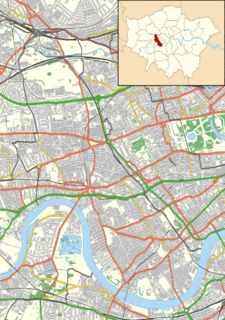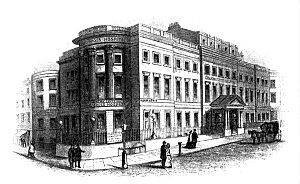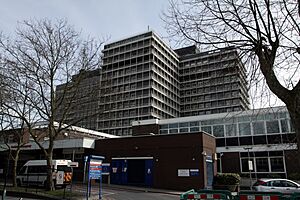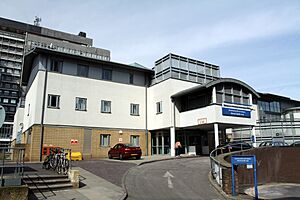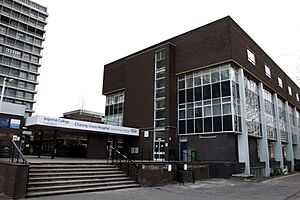Charing Cross Hospital facts for kids
Quick facts for kids Charing Cross Hospital |
|
|---|---|
| Imperial College Healthcare NHS Trust | |
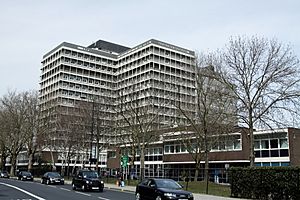
The hospital in 2013
|
|
| Geography | |
| Location | Hammersmith, London, England |
| Coordinates | 51°29′14″N 0°13′10″W / 51.4871°N 0.2195°W |
| Organisation | |
| Care system | National Health Service |
| Hospital type | Teaching |
| Affiliated university | Imperial College School of Medicine |
| Services | |
| Emergency department | Yes |
| Beds | 511 |
| History | |
| Founded | 1818 (as the West London Infirmary, renamed Charing Cross in 1827) |
Charing Cross Hospital is a large hospital in Hammersmith, London. It is also a teaching hospital, which means it helps train new doctors and nurses. The hospital you see today opened in 1973. However, its story began much earlier, in 1818, about five miles away in central London.
The hospital is part of the Imperial College Healthcare NHS Trust. It is the main teaching hospital for the Imperial College School of Medicine. Charing Cross Hospital is a special center for brain and nerve surgery (called neurosurgery). It is also a national expert center for a rare condition called gestational trophoblastic disease. The hospital has a special unit for serious injuries in West London. It was one of the first hospitals to use CT scans, which are special X-rays that show detailed pictures inside the body.
The hospital is home to the West London Neuroscience Centre. This center focuses on the brain and nervous system. There is also a day surgery unit called the Riverside Wing. This unit allows patients to have surgery and go home the same day. The West London Mental Health NHS Trust also has buildings on the hospital site. Charing Cross Hospital hosts the largest and oldest gender identity clinic in the country. This clinic helps people who are exploring their gender identity.
Contents
History of Charing Cross Hospital
How the Hospital Started
In 1818, a doctor named Benjamin Golding started a place called the 'West London Infirmary and Dispensary'. It was located at 16 Suffolk Street, near the Haymarket Theatre. Dr. Golding dreamed of creating a place where poor people could get medical help. The Duke of York and Albany became a supporter, and the hospital was then called the Royal West London Infirmary. Other members of the royal family also became supporters.
By 1821, the infirmary was very busy. It was treating almost 10,000 patients each year. So, a new location was found at 28 Villiers Street, close to Charing Cross in central London. This new infirmary had enough space for twelve beds. Soon after, there were plans to open a medical school next to the infirmary. Over the years, more and more people, including many from the royal family, helped support the hospital.
A New Name and Building
In 1827, the Royal West London Infirmary changed its name to 'Charing Cross Hospital'. This new name was more fitting for its location. Plans for a new building were drawn up in 1830 by an architect named Decimus Burton. A new site was found near the Strand, on what is now Agar Street. On September 15, 1831, the foundation stone was laid by the Duke of Sussex.
The first completed patient ward was named after Princess Victoria, who later became Queen Victoria. The main ward for men was named Golding Ward, after the hospital's founder. The new hospital building was finished in January 1834. It cost about £20,000, which was a huge amount of money back then. In October of that year, 22 medical students moved from Villiers Street to the new building.
Growth and Challenges
The hospital and its medical school continued to grow. When King's College London opened, it needed a medical school. It offered Charing Cross Hospital a lot of money to train its students. Dr. Golding did not agree with this idea. After several years of talks, King's College decided to start its own medical school in 1839. During these years, the Charing Cross medical school faced difficulties. The number of students joining dropped a lot.
By 1840, people's trust in the school returned, and student numbers increased greatly. However, Dr. Golding had a stroke. By 1854, the hospital was doing very well. The top floor, which had been empty, was finally completed. In 1856, Dr. Golding retired as the Director of Charing Cross Hospital Medical School. The hospital faced tough times after several new hospitals with bigger medical schools opened in central London. However, Charing Cross Hospital managed to overcome these challenges. In 1866, it hired professional nursing staff. The hospital was also made larger several times over the next few years. After a big rebuilding project in 1877, the hospital had doubled in size.
20th Century Changes
The hospital was made even bigger in 1902. In 1926, the Royal Westminster Ophthalmic Hospital joined with Charing Cross Hospital. During the Blitz in 1940, which was a time of heavy bombing in London, the hospital staff, students, equipment, and patients moved to Chaulden House in Boxmoor, Hertfordshire. In 1947, after the war, the hospital moved back to Charing Cross.
After the Second World War, it was decided that the hospital should move away from central London. Several places were considered, including a large site at Northwick Park in Harrow. However, the University of London said they could not stay connected with the hospital if it moved there. So, that site was given to the Ministry of Health, which built the current Northwick Park Hospital there.
In 1957, a plan was made to combine Charing Cross with Fulham and West London Hospitals. This idea caused some debate because people in Fulham wanted their existing hospital to be improved, not taken over. A public meeting was held with the Mayor of Fulham. The hospital's Chairman, Lord Inman, explained that the Ministry of Health made the decision. He said that the new hospital would be well-equipped and offer many services. This helped calm most people's worries.
The new Charing Cross Hospital was built on the site of the old Fulham Hospital on Fulham Palace Road. The Queen officially opened it on May 22, 1973. Building the new hospital cost £15 million, which was a huge amount of money at the time. The building was designed by Ralph Tubbs. It has seventeen floors, with 15 floors for the hospital itself and two floors for machinery above that. The building is shaped like a cross. Three tall apartment buildings were built nearby to house medical staff, nurses, and medical students. These buildings were named Golding, Parsons, and Cliff houses. Even though the hospital moved, it kept the name 'Charing Cross'. At first, it was called 'Charing Cross Hospital, Fulham', but later the 'Fulham' part was dropped.
The old Charing Cross Hospital building in Agar Street is a Grade II listed building since 1970. It was changed in the 1990s and became Charing Cross police station.
Famous People Connected to the Hospital
Many notable people have been connected to Charing Cross Hospital:
- David Livingstone: He became a doctor at the hospital. He later became a very famous explorer.
- Thomas Huxley: He also became a doctor at the hospital. He wrote important books like 'Zoological Evidences of Man's Place in Nature'.
- John Astley Bloxam: He was a skilled surgeon at the hospital. He was known for his excellent plastic surgery work, helping patients with certain skin conditions.
- Henry Hyde Salter: A doctor at the hospital who wrote a lot about Asthma.
- Viscount Addison: He worked at the hospital. A part of the human body used as a surgical landmark is named after him.
- Herbert Barrie: A children's doctor at the hospital. He created one of the first special care units for newborn babies in London. He also developed the country's first ambulance for newborns.
How to Get There
London Buses routes 190, 211, 220, 295 and night routes N11, N33, N72 and N97 all stop at the hospital.
Medical School History
The Charing Cross Hospital Medical School joined with the Westminster Hospital Medical School in 1984. Together, they formed the Charing Cross and Westminster Medical School. This combined school then became part of Imperial College London in 1997. The Reynolds Building, which was built for the Charing Cross and Westminster Medical School in 1976, is next to the hospital. It is used a lot by the Imperial College School of Medicine.
Maggie's West London Centre
On April 29, 2008, a Maggie's Centre was opened at the hospital. It was opened by Nigella Lawson and Sarah Brown. This center offers support to anyone in London who is affected by cancer. In 2009, Michelle Obama visited the center. In October 2009, the center won the Stirling Prize from the Royal Institute of British Architects. This award is given for excellent building design.
Famous People Who Died at Charing Cross Hospital
- Jill Dando (1961 – 1999): A BBC newsreader and TV presenter. She died upon arrival at Charing Cross Hospital in 1999 after an incident near her home.
- Geraldine McEwan (1932 – 2015): An actress. She died at Charing Cross Hospital in 2015 after having a stroke.
- Laura Sadler (1980 – 2003): An actress. She died at Charing Cross Hospital in 2003 after falling from a balcony at her home.
- Millie Small (1947 – 2020): A Jamaican singer famous for her 1964 song "My Boy Lollipop". She died at Charing Cross Hospital in 2020 after having a stroke.
Images for kids
-
Henry Moore sculpture at the main entrance


